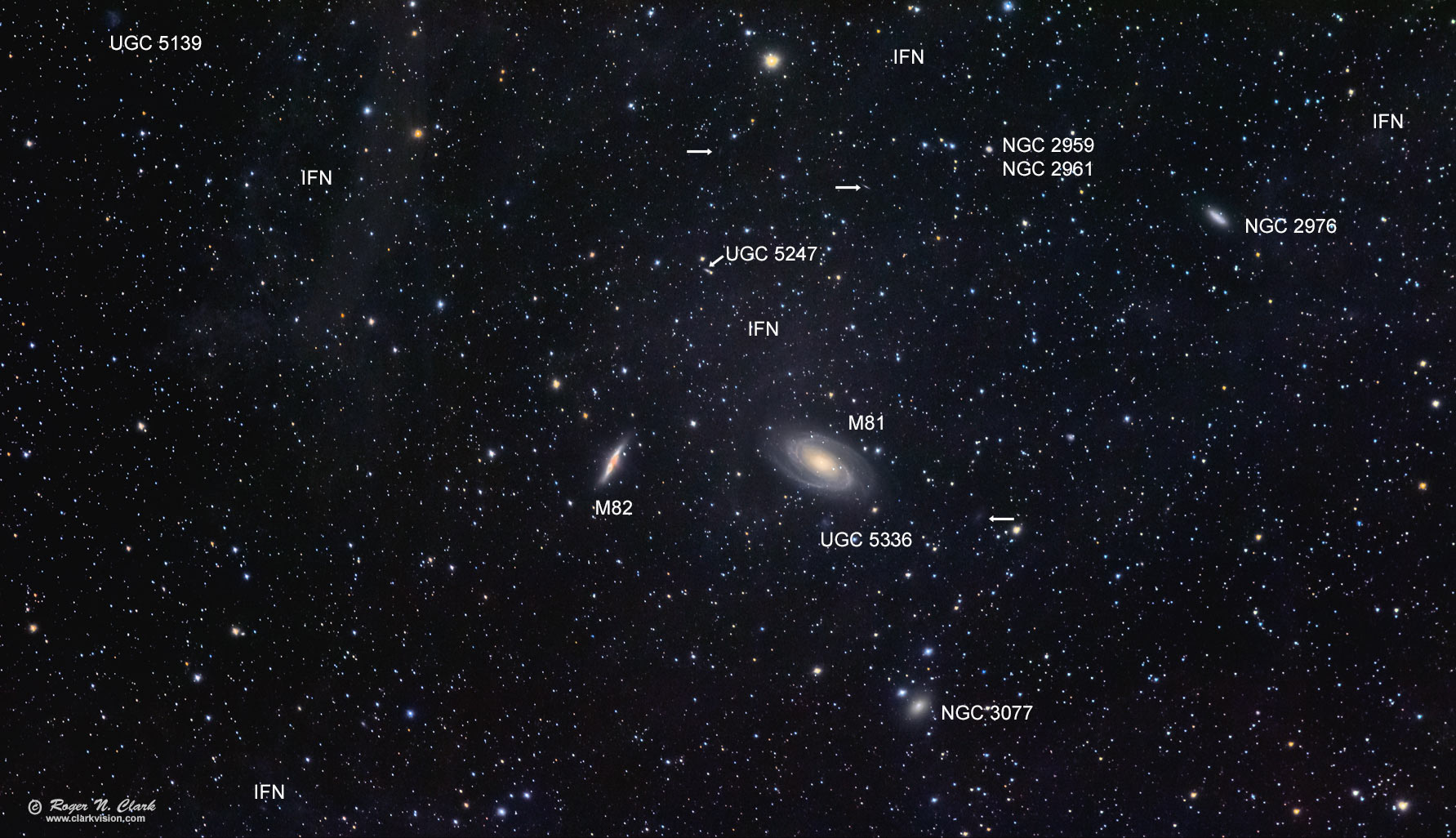| Home | Galleries | Articles | Reviews | Best Gear | New | About | Contact | Gallery Index | Previous |
Next |

| Home | Galleries | Articles | Reviews | Best Gear | New | About | Contact | Gallery Index | Previous |
Next |

Galaxies Messier 81 and Messier 82 are two bright galaxies in the constellation Ursa Major and are surrounded by the extremely faint Integrated Flux Nebula. M81 is on the right and M82 is to the left. Objects are identified in the figure below.
M81 is a spiral galaxy some 12 million light years away. M82 is also about 12 million light years and is undergoing massive starbursts in its core. It is the closest starburst galaxy to the Earth. Both M81 and M82 are nice sights visually is modest-sized amateur telescopes (6-inches or more in aperture).
The Integrated Flux Nebula, or IFN, is composed of dust particles, hydrogen, carbon monoxide and other gases, and is located at high galactic latitudes above the galactic plane. The light is reflected starlight from many stars in the Milky Way, thus the term integrated. The nebula is very faint and is a challenge to image (photometric data below). There is extended red emission from the gases in the nebula, plus blue reflected light from the dust, which can give varied blue, red and purple colors.
This is a natural color image. The high dynamic range of astrophotos must be stretched to bring out the range of details the camera recorded. But the typical image stretch process loses color for brighter subjects (e.g. stars and the brighter parts of deep sky objects become whiter as they are made brighter). This image uses a new algorithm, rnc-color-stretch that does not lose color during the stretch. How do we know the colors are reasonable? The star colors can be checked against stellar photometry. Red stars have B-V > 2, orange stars have B-V of 1 to about 2. The blue-white stars have B-V in the range of 0 to -0.5. The colors closely follow the color sequence in Table 1 at Color of Stars. Solar-type stars have a B-V of 0.63 and appear close to white (daylight white balance).
Technical. Canon 7D Mark II 20-megapixel digital camera and 300 mm f/2.8 L IS II at f/2.8. Forty seven 60-second exposures at ISO 1600 were added (47 minutes total exposure). The Integrated Flux Nebula nebula is extremely faint (see below), so this image demonstrates that the standard 7D Mark II is an amazing low light camera for it to record such faint detail in this exposure. Full resolution image is at 2.8 arc-seconds per pixel, and the image here is 1/3 that (8.4 arc-seconds per pixel). No dark frame subtraction, no flat fields. Tracking with an astrotrac and no guiding.
Photometry using the camera data shows that the sky brightness (camera RGB) was:
red = 21.3, green = 21.8, blue = 22.1 magnitudes / sq. arc-second.
This is about the darkest sky I have imaged in during this solar cycle.
I measured the IFN above M81 at:
red = 24.4, green = 25.8, blue = 25.4 magnitudes / sq. arc-second.
The sensor was at 11 C with dark current of 0.015 electron/second (0.9 electron/exposure),
and read noise was 2.4 electrons.
At these levels, the green channel was receiving about 38 photons from the sky,
and only 0.9 photon/pixel/exposure on average from the "bright" IFN patch above M81 with
fainter patches less than 1/3 that level. Thus, each pixel had about 6.7 electrons of
noise from the sky + dark current + read noise per exposure. So the bright parts of the IFN
had a signal-to-noise ratio of 0.13 and fainter parts only 0.04 per exposure.
This demonstrates the 7D2 with no dark frames, bias or custom flat fields can detect
signals less than S/N = 0.1 per exposure and averaging less than 1 photon
per pixel per exposure. The faintest parts of the image are at about
magnitude 27 per square arc-second.
Post processing: stretched with rnc-color-stretch. Also see Astrophotography Image Processing Basic Work Flow.
The Exposure Factors, CEF, CEFA are measures of the relative amounts of light received from a subject. It can be used to fairly compare wildly different lens/telescope apertures and exposure times. For this image:

Modern DSLRs like the 7D Mark II include On-Sensor Dark Current Suppression Technology and low fixed pattern noise at ISOs around 1600 and higher, making no need for dark frame subtraction. Modern raw converters correct for light fall-off (flat field correction on linear sensor data) and also correct for hot/dead/stuck pixels. This makes processing low light images easy: simply align and average. See my series on Astrophotography Image Processing for more details.
To learn how to obtain stunning images like this, please visit my Extensive Articles on Photography .
See my review of the Canon 7D Mark II and why it is so good for astrophotography: Canon 7D Mark II sensor analysis.
Keywords to this image = astrophoto-1 galaxy Messier night low-light digital_astro canon_7d2 rnc-color-stretch
Image ID: m81+m82-300mmc12.29.2016.0J6A0804-868av47-a2-rs.e-1783s.jpg
| Home | Galleries | Articles | Reviews | Best Gear | Science | New | About | Contact |
Last updated April 02, 2025